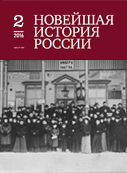Изготовление продовольственных карточек в блокадном Ленинграде. 1941–1943 гг.
The Manufacturing of Ration Cards in the Besieged City of Leningrad, 1941–1943
Author(s): Olga Aleksandrovna Gavrilova, Michail Viktorovich KhodyakovSubject(s): History
Published by: Издательство Исторического факультета СПбГУ
Keywords: Siege; Leningrad; 1941–1943; ration cards; Volodarsky printing factory; I. G. Stozhilov
Summary/Abstract: Based off of a wide range of archival materials, this article reveals a little-known chapter in the history of the Leningrad blockade—the processes involved with the manufacturing of food ration cards for the population of the besieged city. The authors describe the initial phase of the rationing system in Leningrad by showing the diversity of circulating ration cards and coupons which personified the system of rationed food supply. The authors also note that the Leningrad City Soviet Executive Committee’s office for the management and allocation of food and industrial goods ration cards during 1941–42 was headed by Ivan G. Stozhilov. The latter office not only controlled the production of the cards, but was also—for the Party and Soviet bodies involved—one of the main sources in defining the size of the city’s population. The authors’ analysis of documents involved suggests the production of ration cards in Leningrad began hastily after the German attack on the Soviet Union. This work was entrusted to the Volodarskii printing factory located in the vicinity of the Leningrad paper mill which produced the special paper involved. Issues related to the number of cards printed for the city’s populations—as well as the very process of manufacturing of these valuable products—were closely controlled by its Party and Soviet leadership. In 1942, because of the economic state of emergency which city lived under, ration cards began to be produced on plain paper instead of paper with water marks. This latter fact contributed to increasing the number of counterfeit cards. Often the specialists of printing factory themselves were involved in this crime. At the same time there were recorded cases of stealing cards from shops of the printing factories, where they were being manufactured.
Journal: Новейшая история России
- Issue Year: 6/2016
- Issue No: 16
- Page Range: 44-67
- Page Count: 24
- Language: Russian

